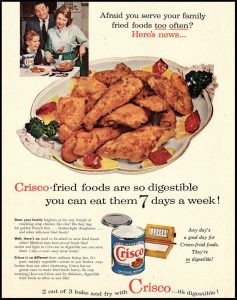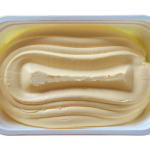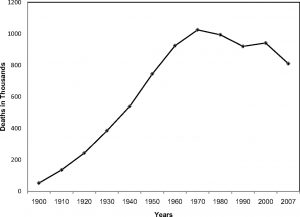One article says trans fats are good for your heart. Another article says trans fat causes debilitating fatigue and heart attacks.
How can those of you following a keto diet know exactly which fats are good and which fats are bad?
If you’re a baby boomer, you grew up learning that butter was evil. Too much butter and you’d be rushed to the hospital with your heart exploding out of your chest. In place of butter, companies offered margarine. Margarine, they said, was good for your heart.
But is it?
Today, new scientific research is shedding light on just how dangerous trans fats like margarine can be. As you’ll soon learn, it may be margarine that’s keeping you fatigued and sending you to the hospital. Not butter.
In this article, I’ll show you exactly which fats you need to avoid if you’re following a keto diet.
Keto dieter’s, avoid this one type of fat
In my previous article, I discussed the difference between fats. Be sure to check it out. It has everything else you need to know about good and bad fats for the keto diet.
Fats are made of carbon and hydrogen atoms in a chain. Depending on the organization between hydrogen and carbon atoms, you’ll get saturated, monounsaturated, or polyunsaturated fats.
When you add hydrogen to liquid oil, it becomes solid at room temperature. Adding hydrogen to liquid vegetable oil creates margarine. Like margarine, artificial trans fats are the result of adding hydrogen to vegetable oil. By adding hydrogen, you change vegetable oil from a polyunsaturated fat into saturated fat.
I’m of the belief that if a food wasn’t consumed throughout the evolutionary history of a species, the food in question is not fit for consumption. For millions of years, your ancestors consumed fruits, veggies, meat, and a minimal amount of grains. The plants and animals consumed by your ancestors evolved with them.
Margarine and other artificial trans fats have been around for about a hundred years. Meaning, only one generation has been exposed to them. Through the lens of evolution, 100 years is a millisecond. 100 years is 0.0001% of the time humans have wandered the globe. It’s this lack of time to these man-made foods that creates many negative effects on our heart’s.
Only humans would be so arrogant to assume that the fat they made in a laboratory is better than the natural fats that have survived millions of years of evolutionary pressure.
Fats that kill
 The first trans fat to hit the market was Crisco. Proctor & Gamble purchased the rights to Crisco in 1910. They then pushed a marketing campaign aimed at housewives.
The first trans fat to hit the market was Crisco. Proctor & Gamble purchased the rights to Crisco in 1910. They then pushed a marketing campaign aimed at housewives.
In their marketing, butter was vilified and Crisco was the savior the housewives needed. (1) Doctors were hired to tout the benefits of Crisco. The same doctors were also told to lie about the risks of consuming butter and animal fats.
Because of the Crisco marketing machine, sales of animal fats started to decline. And sales of Crisco exploded. Just like the ad to the right, advertisers encouraged households to eat Crisco 7x a week.
After Crisco pioneered the trans fat revolution, margarine entered the picture. This just happened to coincide with the great depression of the 1930’s. The lower prices of trans fats pushed consumers to purchase margarine and Crisco over their animal fat equivalents.
The final nail in the coffin for animal fats was when the American Heart Association (AHA) jumped on the trans fat bandwagon. It was the 1950’s and at the time, Americans were dropping like flies due to heart disease. And no one knew why.
Without a single study or piece of evidence to prove its claim, the American Heart Association, claimed animal fats were the problem. Instead of butter, the AHA said your kitchen should be full of trans fats, because these were healthy for your heart. They even came up with a special diet called the Prudent Diet. (2, 3)
The prudent diet?
Imagine eating cold cereals, margarine, Crisco, and lean chicken or fish… The prudent diet is the exact opposite of a keto diet full of good fat sources.
Gross!
No eggs, dairy, fatty cuts of meat, shellfish or pastries. The only fats consumed were to be trans fats. Load up on the Crisco, y’all. All in hopes of decreasing heart disease. This was the Prudent Diet.
The prudent diet was released without any evidence to support the claims that trans fats decreased your risk for heart disease. In 1957, when a study was finally published, the researchers neglected to mention a key piece of evidence…
The published results of the study showed that the prudent diet resulted in lower cholesterol levels compared to those who continued to eat animal fats. (4) These cholesterol levels remained lower for 5 years!
Sounds pretty good, right?
It turns out a key piece of information was not given proper mention in the study. There were 8 deaths from heart disease in the group following the prudent diet. There were zero deaths from heart disease in the control groups that ate eggs and meat on a regular basis. (5) I don’t know about you, but I care far more about not dying than having lower cholesterol!
After these results, the prudent diet slowly disappeared into irrelevance. And for good reason – the prudent diet would probably kill you! Good fats on a keto diet really do offer a protective effect!
Should keto dieters opt for margarine or butter?
Marketers for Crisco and margarine certainly pushed the heart-healthy rhetoric. But this was marketing. Not science. There wasn’t a single human study that backed up the claim that trans fats were healthier or lowered the risk of heart disease.
The information your parents were bombarded with said butter was bad and margarine was good… That was propaganda. There was not a lick of good evidence to support that claim.
At the same time that animal fats were being vilified and trans fats being touted as cure-alls, a study came out that contradicted this point of view. A researcher performed autopsies on people who had died from heart disease. He found artificial trans fats (like margarine!) lining the tissue of human hearts! (6)
Instead of sparking a dietary revolution, this research was ignored. The graph above shows the number of people in the United States that died of heart disease. Notice how the graph peaks at the time when trans fats were pushed as health food. And animal fats were recommended to be avoided.
Maybe that margarine of yours should be replaced with butter! Keto dieters know that healthy fats come from animals. Bad fats come from laboratories.
A big fat revolution
As the graph shows, heart disease only continued to increase until the ’80s. At this time, good research started to arrive. Research that clearly showed trans fat was not good for the human heart.
To prove doubters wrong, manufacturers of hydrogenated fat funded their own study. I’m confident the results of this study were not what the companies were hoping for. Even in a study incredibly biased towards trans fat, it was clearly shown that these man-made fats increase your risk of heart disease. (7) Trans fats are not what keto dieters should be eating.
Even with a mountain of good research, it took North American governments nearly two decades to change their position on fat. Denmark lead the world by implementing an outright ban on trans fat in 2004. (8) And it worked wonders.
After banning trans fats, cardiovascular disease in Denmark plummeted. (9) Before the ban, cardiovascular disease in Denmark was similar to other developed countries. In Denmark, that translated to ~415 deaths per 100,000 people per year from heart disease (before the ban). After banning trans fat, Denmark saved more than 14 lives per 100,000 people every single year! (10)
It took Canada and the United States until 2018 to ban trans fats. (11, 12) Even though there had been compelling evidence to do so decades earlier. In the United States alone, the trans fat ban is estimated to save up to 100,000 lives each year. (13)
If that estimate is true, then the 14+ additional years it took for the USA to ban trans fat would have resulted in 1.4 million people losing their lives to heart disease caused by artificial trans fat.
And this doesn’t even begin to consider the deaths associated with the push to use Crisco and margarine from the 1920’s up until the late ’80s. If it did, the number of deaths connected to trans fats would be massive. More than both the world wars combined.
The fat revolution continues. Research is already starting to show that cholesterol and heart disease aren’t as connected as we originally thought. I suspect in the coming years we’ll start to view all fats in a new light.
Keto anyone?
¡Viva la Revolucion!
Good fats vs bad fats for keto
Good fats for keto can be summarized in a single sentence. If your ancestors had access to the fat, it’s a healthy fat for the keto diet. Another way to get clear if a fat is healthy or unhealthy, ask yourself if you can render or prepare said fat in your household kitchen. Just make sure you have the right genes – otherwise your cholesterol could increase!
Animal fats can be rendered on your stove-top. Fats from plants like soy or corn require immense amounts of pressure and highly specialized equipment. There’s no way you could extract oil from corn on your stove-top.
Bad fats for keto can be summarized in a single sentence. If the fat in question requires a special processing facility to be made, it’s an unhealthy fat for the keto diet.
Follow this rule and you’ll be on your way to a heart-healthy keto diet!
Now, I want to hear from you!
What healthy fats are you sure to include on your keto diet?
Which fats are you sure to avoid on your keto diet?
Leave your answers in the comments section below!

